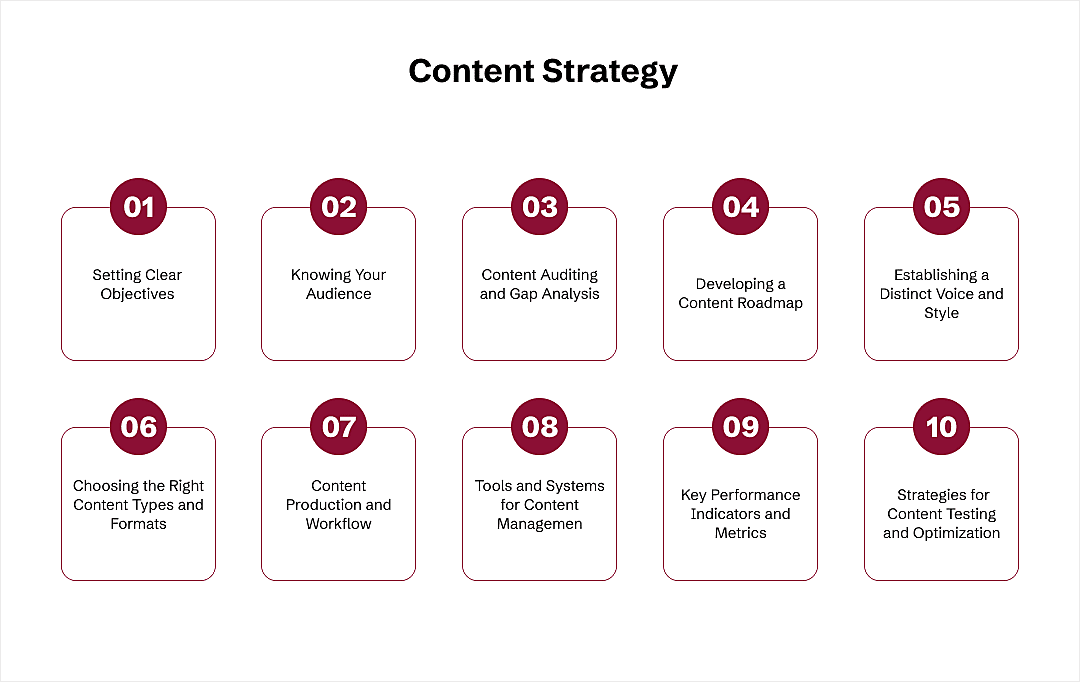
- Understanding Content Strategy
- Key Differences Between Content Strategy and Content Marketing Strategy
-
Core Components of a Successful Content Strategy
- Setting Clear Objectives
- Knowing Your Audience
- Content Auditing and Gap Analysis
- Developing a Content Roadmap
- Establishing a Distinct Voice and Style
- Choosing the Right Content Types and Formats
- Content Production and Workflow
- Tools and Systems for Content Management
- Key Performance Indicators and Metrics
- Strategies for Content Testing and Optimization
- Conclusion

Are you feeling overwhelmed by the thought of building a content strategy? You're far from alone. Did you know that 80% of successful businesses have a documented content strategy? Without one, you'll be creating content unquestioningly. You may get somewhere, but certainly nowhere near where you want to go.
This article will walk you through the process of how to create a content strategy in ten expert steps. From defining objectives to measuring success, you'll learn how to create and distribute relevant content that speaks to the audience and works to establish brand awareness for business growth. Let's dive in and set you apart from the competition.
Understanding Content Strategy
Building a content strategy defines your overall approach to content creation strategy and distribution. It considers what your purposes and goals are, whom you are targeting, and how these objectives are going to be achieved. You need various content forms to build brand awareness, engage an audience, or drive revenue growth.
According to the State of Content Marketing report, 80% of organizations with high success rates have a documented content strategy. This data-driven approach allows one to use many resources effectively and efficiently, ensuring that your creation efforts align with business goals and audiences' needs.
Key Differences Between Content Strategy and Content Marketing Strategy
While these terms are used interchangeably, content strategy and content marketing plan refer to related but quite distinct concepts. The content strategy is a high-level roadmap documenting the mission, goals, and plan for content creation and sharing. In other words, it shows the "why" behind all this effort.
In comparison, a content marketing plan deals with implementing this strategy by creating, publishing, and promoting such content to attract, engage, and turn your target audience into leads. This subset is known as a content marketing strategy, that includes ownership, CTAs, and distribution channels.
Be it building a content strategy, identifying your target audience, determining the key performance indicators, or setting content types that more effectively resonate with an audience, you will know how to lay a foundation for effective marketing campaigns.
Core Components of a Successful Content Strategy
When building your content strategy, incorporating innovative marketing strategies for startups can set your brand apart and drive growth. Creating a successful content strategy involves more than just generating content. It requires a structured plan that aligns with your business goals. By implementing content strategy best practices, you can ensure your content is effective, engaging, and targeted. Additionally, integrating small business marketing strategies to propel growth can further enhance the effectiveness of your approach.

Here are a few content strategy best practices that guarantee measurable results and sustained audience engagement.
1. Setting Clear Objectives
Setting clear objectives is the base of any successful content strategy. It aligns what a business does regarding its content creation strategy and distribution with the broader goals of the company.
First, find out what you want from your content. Here’s a content strategy example - confirm whether your content will create brand awareness, generate leads, or drive sales. There is a need to be specific. In other words, objectives like "increase website traffic to 20% next quarter" unmistakably make it clear what the purpose is. Make sure the objectives align with your KPI's measurable results against which you can benchmark your progress and further refine your strategy where necessary.
2. Knowing Your Audience
One needs to understand the audience to create relevant and engaging content. It is one of the best content strategy tips. This begins with in-depth research into your target audience: existing customers and potential prospects across different journey stages. The research provides you with the big picture of how to create content that will answer various needs and pain points. Tools at your command in this respect are surveys, analytics, and social media insights. An example of a content strategy is using the data to develop detailed audience personas to guide your content planning toward authenticity and value generation.
The more you know about your audiences, the more effective your content will likely be at encouraging engagement and driving conversions
3. Content Auditing and Gap Analysis
Another content planning tip is running a content audit and gap analysis that will help refine the strategy by knowing what works and what doesn't. Audit current content in detail to understand how well it performs using metrics such as engagement, traffic, and conversions.
Identify gaps against what is available by comparing against audience needs or search trends. Through this analysis, you can evaluate the requirement of new content or repurposing existing ones to fill the gaps. Various headline analyzer tools also help in strengthening titles and headlines. Ensure that you stay relevant to your audience at all times with deep audits, ensuring that your content stays in line with your objectives.
4. Developing a Content Roadmap
A content roadmap will help you track what is happening and stay focused on the big picture. Start with the critical business goals and objectives, decompose them according to action items, and extract key content themes and subjects quarterly. Add timelines to build consistency in content creation strategy and distribution. Check on upcoming trends and seasonal opportunities to maintain relevance. Use editorial calendar tools that hold deadlines but ask for progress updates in return.
5. Establishing a Distinct Voice and Style
Developing a content strategy requires you to establish a unique voice and style for brand identity. This first step to defining one's brand voice includes considerations and preferences of one's target audience and the core values of one's business. Use this everywhere uniformly. Create a style guide that addresses tone, language, and formatting standards. This guide should be shared with all content creators so that there is consistency. So, as much as it builds your brand's recognition, the consistency in voice and style will foster trust and loyalty among your audience.
6. Choosing the Right Content Types and Formats
The more appropriate the formats and types of content, the higher engagement and retention. Analyze your audience's preferences and information consumption methods to define the best formats. Here are some content strategy examples: a blog post, video, infographics, and podcasts.
Diversify the content mix to reach different segments of your target audience; for example, using blog posts and videos to give deeper information to visual learners. Adopting a varied approach in your content strategy framework will keep your audience interested and engaged.
7. Content Production and Workflow
An effective content creation goes hand in glove with an effective content strategy. A clearly defined, direct workflow will help complete all tasks on time and within available resources. Start by explaining each step, from ideation to publication, then determine the functions corresponding to every team member. Organize content calendaring and schedule posts with deadlines that will help in managing content at various stages of work.
Hold regular progress meetings and problem-solving sessions to build an environment that encourages cooperation. Be open to flexibility to make the changes fast. Automate formatting and distribution of documents whenever possible for increased productivity. Implementing marketing strategies to grow business can streamline the process and ensure your content aligns with broader business objectives.
8. Tools and Systems for Content Management
The proper choice of tools and systems for managing content will significantly influence how smoothly a strategy can be performed. A quality Content Management System is essential for performing contentful localization and workflow management.
Keep tabs on how the content is doing using analytics platforms to enable yourself to make informed decisions in the future. Scheduling tools for social media keep the consistency and posting frequency of different accounts in check, while project management tools help teams with tandem working.
Think about SEO tools, email marketing tools, and audience profiling tools that can enhance your content strategy. Tools like these provide valuable insights to base your decisions on and automate complex processes so your content will end up in front of the right person at the right time.
9. Key Performance Indicators and Metrics
KPIs can let one know how effective a content development strategy is. They are metrics that define success. Conversion rates show the effectiveness of the content in compelling actions like signing up or purchasing.
Your business objectives will help you determine the relevant KPI to suit the time. For instance, metrics such as social media reach and impressions will be considered when it comes to brand awareness. For lead generation, it will dwell on click-through rates and the lead conversion rate. This performance will consistently be tracked to understand what works and doesn't.
10. Strategies for Content Testing and Optimization
Testing and optimizing your content does not end here. A few ways to do this are by creating A/B tests, which pitch two different versions against each other. Variables include headlines, images, or even call-to-action buttons that decide what helps drive better results in your content. Guide such efforts toward the optimization of content using data from these tests.
Use Contentful localization at your fingertips to tailor your content to specific demographics and enhance your strategy. Test various formats, such as blogs, videos, and infographics. See how each one performs. Also, continue to update your content for relevance and engagement per the performance metrics.
Conclusion
A successful content strategy will define clear objectives, understand the audience, and require continuous optimization. Clearly defining what your goals are, doing thorough homework on your audience, and using the right tools and systems will enable you to develop a strategy that’ll drive not just engagement but help achieve business goals as well.
Keep an eye on the regular content audit during development, measure performance, and be adaptable to trends and audience feedback. Follow these steps and your content will be relevant, have the effectiveness of communicating the vision of your brand, and make it stand out in the market.

Content Writer
Sakshi Kaushik is a wordsmith extraordinaire who transforms complex technical jargon into captivating, must-read articles. Armed with a Masters in Economics, Sakshi dissects intricate topics with the precision of a seasoned expert. Her insights have graced prestigious platforms like Hackernoon, Ecowiser, and Medium, captivating readers and tech aficionados alike. With a career spanning influential companies like Teleperformance, Finex, and SparxIT Solutions, Sakshi is well-versed in navigating both the keyboard and the boardroom.
In addition to her extensive experience, Sakshi holds HubSpot certifications in Digital Advertising and Content Marketing, and has earned further credentials from UpGrad, Coursera, and Great Learning. Dedicated to sharing her expertise with mobile app developers and tech enthusiasts, Sakshi's passion shines through her writing. When she's not crafting compelling content, she enjoys diving into thrilling novels and exploring diverse worlds.












